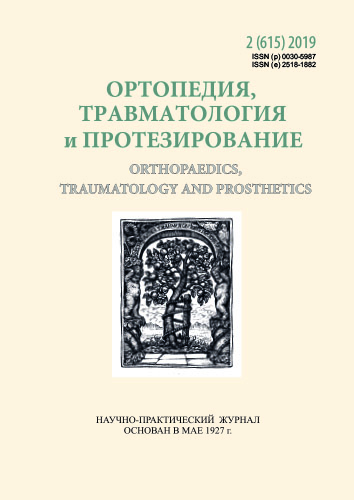Orthoses for dynamic stretching of contractures of knee joints in children
DOI:
https://doi.org/10.15674/0030-59872019287-92Keywords:
contractures, knee joint, dynamic stretching, orthotics, designs, knee jointsAbstract
Conservative treatment of knee joint contractures with dynamic orthoses (DO) is an important step in rehabilitation of children with pathologies of the musculoskeletal system.
Objective: To determine the possibility of using DO on knee-ankle joint (foot) with pneumatic cylinders and knee joints with a flat spiral spring for conservative treatment of contractures of knee joints in children.
Methods: 7 children completed a course of rehabilitation treatment with new designs of DO (with knee joints with a flat spiral spring or pneumatic cylinders) for flexion contractures of knee joints with the background of neurological diseases. The feature of DO with a flat spiral spring is the ability to perform dynamic linear correction of flexion/extension contractures of knee joints. The use of hinges allows the use of a constant correction force, which is created using a selected individually adjustable flat spiral spring, over a long period. DO with pneumatic cylinders allow to carry out dynamic correction of the flexion contractures of the knee joint with a linear force that depends on the gas pressure in the pneumatic cylinder and usually decreases by 30 % in case of complete compression of the latter.
Results: The testing of the proposed DO confirmed the effectiveness of their use and the expediency of introduction of new designs of orthopedic products at Ukrainian industrial enterprises.
Conclusions: Conservative treatment with new designs of DO for stretching of knee joint contractures in children is a sufficiently effective means of eliminating the pathological position of the joint and restoring a significant amount of movement in it. The designed constructions of DO will allow an individual approach to each patient, depending on the nature of the disease, its severity and the anatomical features of the child.
References
- Bakulev, A. N. (1959). Big Medical Encyclopedia: 36 t. Moscow: Medgiz. (in Russian)
- Farmer, S. E., & James, S. E. (2001). Contractures in orthopaedic and neurological conditions: a review of causes and treatment. Disability and Rehabilitation, 23 (13), 549–558. doi: 10.1080/09638280010029930
- Williams, P. E. (1990). Use of intermittent stretch in the prevention of serial sarcomere loss in immobilised muscle. Annals of the Rheumatic Diseases, 49 (5), 316–317. doi: 10.1136/ard.49.5.316
- Warren, C. G., Lehmann, J. F., & Koblanski, J. N. (1976). Heat and stretch procedures: an evaluation using tail tendon. Archives of Physical Medicine and Rehabilitation, 57 (3), 122–126.
- Williams, P. E., Catanese, T., Lucey, E. G., & Goldspink, G. (1988). The importance of stretch and contractile activity in the prevention of connective tissue accumulation in muscle. Journal of Anatomy, 158, 109–114.
- Booth, C. M., Cortina-Borja, M. J., & Theologis, T. N. (2007). Collagen accumulation in muscles of children with cerebral palsy and correlation with severity of spasticity. Developmental Medicine & Child Neurology, 43 (5), 314–320. doi: 10.1111/j.1469-8749.2001.tb00211.x
- Alter, M. J. (1996). Connective tissue: a limiting factor of flexibility. Science of flexibility. Leeds: Human Kinetics.
- Ultraflex Europe. Training manual. Dirame Ortho. — Brussels, Belgium: Ultraflex Systems Inc, 2000.
- Korneev, S. V., Pivovarov, V. V., Baev, P. A., Zaytsev, M. V., & Tovkach, S. P. (2018). Knee joint for lower limbs orthoses. Patent 117529 UA (in Ukrainian)
- Baev, P. A., Pivovarov, V. V., Korneev, S. V., Petrov, V. G., & Tovkach, S. P. (2018). Knee joint for lower limbs orthoses. Patent 117169 UA. (in Ukrainian)
- ORLAU Manual. The contracture correction device for treatment of knees. UK ORLAU Publishing Ltd, 2003.
- . Farmer, S. E., Woollam, P. J., Patrick, J. H., Roberts, A. P., & Bromwich, W. (2005). Dynamic orthoses in the management of joint contracture. The Journal of Bone and Joint Surgery. British volume, 87-B (3), 291–295. doi: 10.1302/0301-620x.87b3.15445
- Lunsford, T. R., & Wallace, J. M. (1997). Orthotic Prescription. Atlas of orthoses and assistive devices. Mosby-Year Book. Inc.
Downloads
How to Cite
Issue
Section
License
Copyright (c) 2019 Pavel Bayev, Viktor Pivovarov, Sergey Korneev, Vladymyr Petrov

This work is licensed under a Creative Commons Attribution 4.0 International License.
The authors retain the right of authorship of their manuscript and pass the journal the right of the first publication of this article, which automatically become available from the date of publication under the terms of Creative Commons Attribution License, which allows others to freely distribute the published manuscript with mandatory linking to authors of the original research and the first publication of this one in this journal.
Authors have the right to enter into a separate supplemental agreement on the additional non-exclusive distribution of manuscript in the form in which it was published by the journal (i.e. to put work in electronic storage of an institution or publish as a part of the book) while maintaining the reference to the first publication of the manuscript in this journal.
The editorial policy of the journal allows authors and encourages manuscript accommodation online (i.e. in storage of an institution or on the personal websites) as before submission of the manuscript to the editorial office, and during its editorial processing because it contributes to productive scientific discussion and positively affects the efficiency and dynamics of the published manuscript citation (see The Effect of Open Access).














